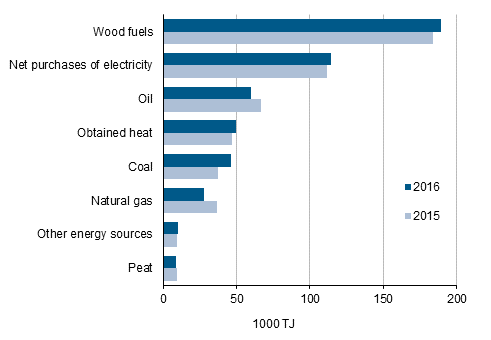Published: 3 November 2017
Energy use in manufacturing grew by close on one per cent in 2016
According to Statistics Finland, energy use in manufacturing grew by close on one per cent in 2016. Manufacturing consumed 507 petajoules (PJ) of energy, which was 0.8 per cent more than in the year before. Total use of electricity increased by 0.7 per cent from the previous year.
Use of energy in manufacturing

The decrease in industrial production that has continued since 2012 made an upturn last year, which was also visible as an increase in energy use in manufacturing. Energy use has not, however, grown at the same rate as industrial production as among energy-intensive industries, production decreased in the chemical industry year-on-year, which also meant that energy use in the industry continued declining. Despite the growth, energy used in all manufacturing was still far from the levels seen in the peak year 2007. In the ongoing decade, manufacturing has consumed less energy than in 2016 only in 2015.
Wood fuels were still the biggest source of energy in manufacturing with a 37 per cent share. The use of wood fuels went up by nearly three per cent. Just like in 2015, oil products were the second most important source of energy. However, the consumption of oil products decreased by around ten per cent. The consumption of natural gas also continued declining and dropped by more than 20 per cent year-on-year. By contrast, the consumption of coal grew by as much. The growth in consumption of coal is caused by the use of hard coal being widened to a new use in the process industry.
In fuel use, the consumption of fossil fuels and peat continued to decrease. Last year, consumption of all fuels was still nearly 20 per cent lower than in 2007 prior to the financial crisis. Consumption of wood fuels has, however, remained almost at the same level. As consumption has decreased, the structure of consumption has shifted from fossil fuels and peat towards renewable energy sources.
Even though many factors affect the use of fuels, such as the relative prices of various fuels, it would seem that the change in the structure of consumption constitutes a permanent trend. The consumption of peat has almost halved, the consumption of natural gas has halved and nearly one third less oil is also consumed than in 2007. Despite the increase in the use of coal in 2016 its consumption was nonetheless close on twenty per cent lower than in 2007.
Total use of electricity increased in pace with other energy consumption, that is, by 0.7 per cent. Total use describes the total amount of electricity used in manufacturing. By contrast, net acquisition of electricity increased by 2.8 per cent. Net acquisition refers to the difference between the purchases and sales of electricity users. Only a few actors have their own production of electricity and, thus, sales or delivery of electricity. Big users can have very large volumes of electricity use (total use) but still net acquisitions can be negative if electricity from one’s own use is left over to be sold on the market. When calculating the use of energy in manufacturing, the use of electricity is included as net acquisitions. The energy use of actors who produce electricity themselves is not excluded from the statistics, however, it is visible as fuels used in the production of electricity. Due to this conceptual difference, the use volumes of electricity differ from each other, for example, in Appendix tables 1 and 3.
The consumption of heat in manufacturing grew by five per cent from the year before. The consumption of district heat was boosted by cooler weather than in the year before and the amount of steam used in industrial processes increased due to the growth in production.
The industry-specific structure of energy use in manufacturing has remained almost unchanged. The forest industry still consumes nearly one-half of the energy used, and together with the chemical industry and manufacturing of basic metals it stood for 80 per cent of total use of energy in manufacturing. The forest industry is, besides a large energy consumer, also a considerable producer of energy. The forest industry produces a majority of the electricity and heat that it uses with its own fuels. These renewable fuels generated from production effluents create a considerable share of the use of renewable fuels in Finland.
Viewed by region, energy use in manufacturing was highest in South Karelia, while one year earlier most energy was consumed in Uusimaa. In total use of electricity, Lapland was clearly the biggest consumer of electricity, just like one year earlier. In energy consumption, regional distribution follows the geographical distribution of heavy, energy-intensive manufacturing.
Source: Energy use in manufacturing, Statistics Finland
Inquiries: Anssi Vuorio 029 551 3668, energia@tilastokeskus.fi
Director in charge: Ville Vertanen
Publication in pdf-format (283.8 kB)
- Tables
-
Appendix tables
- Figures
-
- Appendix figure 1. Use of energy in manufacturing (3.11.2017)
- Appendix figure 2. Energy use in manufacturing by energy source (3.11.2017)
- Appendix figure 3. Energy use in manufacturing by industry (3.11.2017)
- Appendix figure 4. Energy use in manufacturing by region (3.11.2017)
- Appendix figure 5. Total electricity consumption in manufacturing (3.11.2017)
- Appendix figure 6. Total electricity consumption by manufacturing branch (3.11.2017)
- Appendix figure 7. Total electricity consumption in manufacturing by region (3.11.2017)
Updated 3.11.2017
Official Statistics of Finland (OSF):
Energy use in manufacturing [e-publication].
ISSN=1798-7776. 2016. Helsinki: Statistics Finland [referred: 18.7.2024].
Access method: http://www.stat.fi/til/tene/2016/tene_2016_2017-11-03_tie_001_en.html

